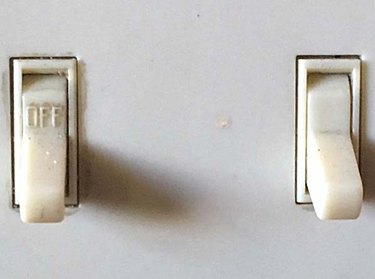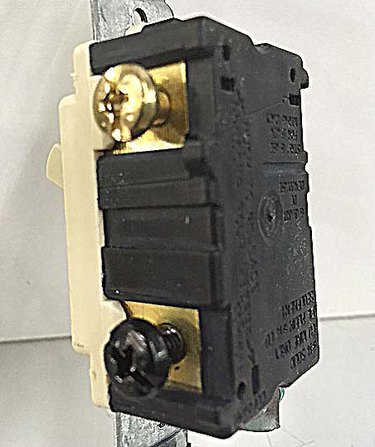
Single-pole and three-pole -- or three-way -- switches look almost the same when installed, but there is one big difference. Whereas a single pole switch has "on" and "off" markings, a three-way switch doesn't. That's because the three-way switch is used in conjunction with another three-way switch to power a single light fixture, and turning the light fixture on and off may require different lever positions.
Closer inspection also reveals that a single-pole switch has two brass-colored hot screw terminals, but a three-way switch has three -- two traditional hot screws and what is known as a "common" screw terminal.
Video of the Day
Video of the Day

A Single-Pole Switch Has Two Hot Terminals
Because a single-pole switch controls a single fixture, it has two fixed positions: on and off. When you examine the switch, you'll see that it has two brass terminals and a green ground terminal. In typical home wiring, the hot wire from the electrical supply connects to one terminal and the hot wire to the fixture connects to the other. Both wires are usually black, which is one of the two colors the National Electrical Code assigns to hot wires. (Red is the other allowable color.) The terminal screws are brass-colored because that is the code designation for hot terminals. The neutral wires are spliced together inside the switch box and bypass the switch, so a switch has no silver neutral terminals.

A Three-Way Switch Has an Extra Terminal
A three-way switch has the same two brass terminals you find on a single-pole switch, although they are usually opposite each other instead of arranged vertically on the switch body. In addition, the three-way switch has a black terminal. It's there so the electrician can connect the switch to another three-way switch via a third wire. When properly wired to each other and to a light fixture, either switch can control the fixture.
When making the connections, electricians run a three-conductor cable between the switches. This cable includes an extra hot wire, which is red, and this is the wire that electricians normally use to connect the black screws. It's commonly known as the traveler wire. Although each switch in a three-way set-up only has two physical positions, the positions can change from on to off, depending on the position of the other switch.

Common Uses
Single-pole switches are most commonly used in home lighting circuits to control one or more lights or fixtures from a single location, such as the entrance to a room. Three-pole or three-way switches are used to control one or more lights or fixtures from multiple locations, such as the top and bottom of a flight of stairs.